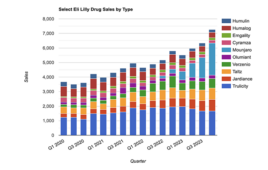 Biopharma is increasingly harnessing the power of data collected outside of a controlled clinical environment to generate valuable insights to support products throughout their lifecycle. Recent advances, such as greater availability of information technology and stronger observational research methods, have improved our ability to leverage real-world data sources, making them attractive tools for research use. As we continue to investigate and use these sources to strengthen evidence of real-world safety and effectiveness and influence value-based purchasing and pricing, we recognize the importance of selecting the right data source and study design for a given research question. Given the number of potential clinical data sources and their increasing availability for research, selection of an appropriate source is challenging. Here we examine how to best leverage these data in today’s complex environment.
Biopharma is increasingly harnessing the power of data collected outside of a controlled clinical environment to generate valuable insights to support products throughout their lifecycle. Recent advances, such as greater availability of information technology and stronger observational research methods, have improved our ability to leverage real-world data sources, making them attractive tools for research use. As we continue to investigate and use these sources to strengthen evidence of real-world safety and effectiveness and influence value-based purchasing and pricing, we recognize the importance of selecting the right data source and study design for a given research question. Given the number of potential clinical data sources and their increasing availability for research, selection of an appropriate source is challenging. Here we examine how to best leverage these data in today’s complex environment.
Real-world data can be divided into two key types: primary data, which are collected specifically for research purposes; and secondary data, which are collected for purposes other than the research question of focus. Primary data are generally obtained from study-specific case report forms and/or through clinical outcomes assessments such as Patient-Reported Outcomes (PROs). These data are collected in nonexperimental prospective observational studies, patient registries and health surveys. Additionally, real-world patient data can be collected through interventional Phase 3B and 4 trials, which include supplemental data collection within traditional randomized controlled trials (RCT piggybacks) and pragmatic studies. Secondary data are often obtained from clinical chart reviews, electronic medical and health records, existing registries or administrative sources, such as insurance claims.
Retrospective database studies look backward in time using secondary data, thus having the potential to generate large, real-world sample sizes quickly and efficiently. However, they are limited by the fact that the data already exist and there is no control over what elements are collected. Prospective study designs, which generally require primary data collection, allow a high degree of control over data elements collected. These generally take longer and cost more than retrospective designs. Hybrid studies using mixed data models combine elements of both of these approaches through prospective data collection and the use of retrospective administrative data, creating efficiencies in study operation. A hybrid study combines automated, passive data capture with active, de novo data collection, to create a data set with broad application. In this setting, EMR or claims data can be used retrospectively for baseline data collection, and prospective EMR feeds can proceed in parallel with direct-to-clinician and direct-to-patient survey administration.
A firm understanding of stakeholder and evidentiary needs is a critical first step in the process of selecting an appropriate data source and study design. A number of factors influence which data source, study design, and timing of data collection will be ideal for a given research question. First, consider whether the required data elements are recorded in routine clinical practice or through healthcare administration, and if so, where specifically would these data be found? Are they available in electronic medical records or claims, and if not, is chart review a possibility? Answers of “yes” to these questions lead to use of secondary data. If data elements are not routinely collected, prospective data capture may be the solution. The middle ground hybrid approach allows for the combining of these approaches to capture what is possible from electronic databases and augment with primary data collection.
Every study is unique, and there are a variety of flexible frameworks for tapping into the power of real-world data sources to effectively and efficiently answer research questions. These data are recognized as an increasingly valuable asset for research at all points of the drug development process. Practical considerations for customized and creative uses of data can help researchers generate the most robust study conclusions.
Filed Under: Drug Discovery




